Apple's iPhone 4: Thoroughly Reviewed
by Brian Klug & Anand Lal Shimpi on June 30, 2010 4:06 AM EST- Posted in
- Smartphones
- Apple
- iPhone 4
- Gadgets
- Mobile
Screen - Retina Display
Right out of the box, the iPhone 4's new 326 PPI, 960x640, 3.5" display is arguably the single most striking change the new iPhone brings. In a word, it's dazzling. Text and high res images look amazingly sharp on the iPhone 4’s retina display. It’s an improvement over the 800 x 480 AMOLED screens that have been shipping on most Android phones. But if you’re comparing it to an iPhone 3GS the difference is huge.
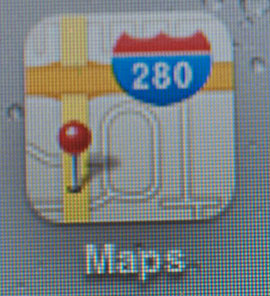 |
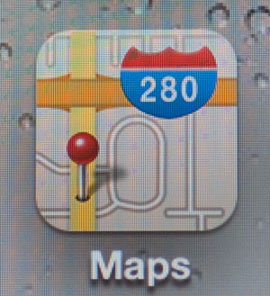 |
|
iPhone 3GS
|
iPhone 4
|

Text on the Google Nexus One

Text on the iPhone 4
The dot pitch is truly remarkable, so much so that Apple makes the claim that their display outresolves the human eye; its advertised ability to do so has earned it a new Apple tradename, "retina display."
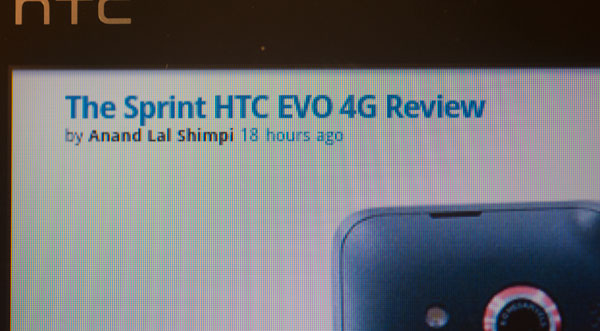
Text on the HTC EVO 4
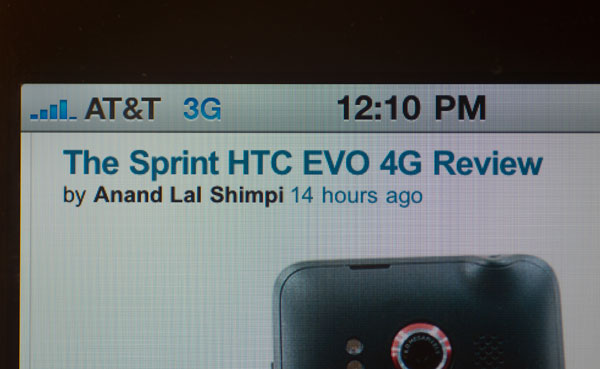
Text on the iPhone 4

AnandTech Logo on the EVO 4G

AnandTech Logo on the iPhone 4
Immediately after hearing Apple's claim that the Retina Display outresolves the human eye, I snapped into optics mode and crunched the numbers, and tweeted that the results were valid.
In the days that followed, there was considerable debate about the validity of Apple's claims. However, nearly all of the debate really just hinged on a debate over angular resolution of the human eye, and a little more over viewing distance. They're both entirely conventions.
As you've probably discovered by now, the human eye resolution can really only be characterized in angular subtense. Hold something closer to your eye, and you can see smaller features better (in theory), move it further away, and you can't make out small spatial details. The minimum angle visible with the human eye is the angle at which features (for the most common definition, a black and white square wave) stop being visible, and are indistinguishable from each other.
Most measures of visual acuity test with this implicitly - the Snellen eye chart's use of the capital "E" is literally a perfect example, which has given rise to a "tumbling E" eye chart. At twenty feet, the capital E subtends 5 minutes of arc, and conveniently has five half cycles of white to black (from top to bottom). So 20/20 implicitly implies an angular resolution of 1 arcminute (1/60 degrees).
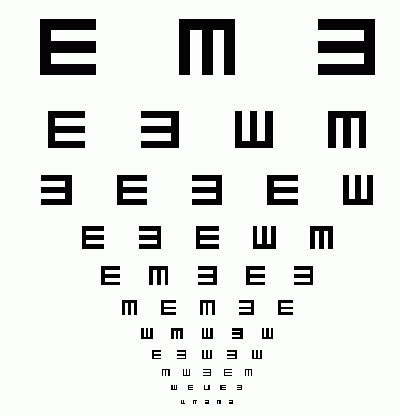
As an Optical Sciences and Engineering undergrad, I've had 1 arcminute drilled into my head more times than I can count as being the "normal" angular resolution of the human eye system. In practice, this is 20/20 vision, which is "normal," yet not perhaps the absolute maximum for human perfection. We can play games of course and argue that a small subset of the population has better than normal uncorrected vision, and thus an angular resolution of below 1 arcminute. I have above average uncorrected vision, which I've measured to be 20/15 on average, giving an angular resolution of approximately 0.75 arcminutes. Of course, the definitions stem from the spacing of cones in the fovea, the highest resolution part of the retina.
The other informational quantity needed to test the Retina Display claims is viewing distance. Again, there's a commonly agreed upon convention - standard viewing distance is considered to be 1 foot. This is another drilled into my brain number tossed around for comfortable viewing and reading. In practice, you can focus on objects much closer to your eye - this is called the near point and is often given as 10 inches, though as you get closer you increase strain aren't likely to keep it here.

Maybe not exactly the limit, but close enough.
Given the two most common standards tossed around, 1 arcminute and 12 inches, do the math out and you'll arrive at around 286 pixels per inch as the limit for eye resolving power, comfortably below the 326 on the Retina Display. Move to 0.75 arcminutes at 12 inches, and it's 382 pixels per inch, higher than the Retina Display. Honestly, I can't see the pixels at 12 inches.
Of course, the real story is even more complicated. Remember how the definition comes with the implicit assumption that we're dealing with a square wave pattern from white to black? That's a factor too - the contrast of the two pixels. Lower the contrast, and the eye's ability to pick out features decreases even more. So far, everything we've talked about has been first order, and without aberrations. Toss in spherical and astigmatism, two aberrations common to the eye system, and eye performance drops way more.
The human eye system is actually pretty poor, and shockingly easy to outresolve. In fact, if you saw the image your eye forms on your retina, you'd likely be appalled; it's your brain that makes the system usable. But at the end of the day, Apple's claims that the display outresolves the human eye are good enough for us.










270 Comments
View All Comments
MacTheSpoon - Wednesday, June 30, 2010 - link
Hi, thanks for a really great review (I hope this isn't a double post, I had a problem when I submitted this before). I especially liked the hard numbers you used to measure things. Seeing the screen black levels, brightness, and contrast, plus how they compared to other phones, was really wonderful. I did have a few questions:1. Are you sure it's reasonable to conclude the maximum drop in signal strength when holding the phone is 24 dB? Doesn't skin capacitance vary from person to person? Also, I've seen some people put keys on their phones to connect the two antenna and demonstrate the reception problem, and I wonder if you could consider measuring the dB effect for that as well. Considering that keys are often kept in pockets with cellphones and could rest against the phones it seems like a reasonable scenario to explore.
2. Did you mention the problems people have had with the glass shattering easily? I've read many reports of this online. I didn't notice it but perhaps I did not read closely enough.
3. Since a case is, as you say, a must-have accessory for the phone, not only for the antenna but also apparently for the brittle enclosure, it seems unfair to give the phone credit for being 9.3 mm thin. Could you please give the thickness of the phone with the bumper? That seems to be its real thickness to me, honestly.
Thanks again for the review!
PhilBrandn - Wednesday, June 30, 2010 - link
See this video:http://vimeo.com/12951893
Even replicating the problem doesn't seem to force a dropped call.
MacTheSpoon - Wednesday, June 30, 2010 - link
It does, actually. Check this out:http://www.youtube.com/watch?v=03PQyWp0mWE
bill4 - Wednesday, June 30, 2010 - link
Cant shake the feeling of overwhelming Apple bias from most tech sites, and Anandtech.It doesn't help that it seems every tech editor's personal phone is an iPhone. And that's most certainly not because it's better, in fact in most cases the iPhone is objectively inferior to other phones.
This line in the article:
"On top of the battery life improvements Apple finally plays catch up and surpasses the technological advancements in its Android competitors. The 4's camera is as good as it gets today and the screen is a beauty. I don't believe this advantage will last for the lifetime of the iPhone "
Battery life is routinely massively overrated by Anand, it's simply not as important to most people as it seems to be to Anand. Charge your phone each evening and it's done. What's the big deal? Seems like the unnatural battery life obsession is just a way to give fake props to Apple in every review.
Likewise, "surpasses the technological advancements in its Android competitors. " Huh? Not hardly bud. By far the most important metric these days is screen size. Yes, it's probably not politically correct to say, I should talk about "usability" or some other subjective thing so we can pretend Apple is the winner, but it's the hard truth. Android phones have 4.3" and 4" screens aplenty. That's why I'm way more excited over the Evo, the Droid X, the Galaxy S, then a lame 3.5" iPhone revision. The iPhone 4 screen is actually (slightly) smaller than the 3GS screen (though they're both nominally 3.5" in screen area the 4 screen is smaller than the 3GS screen)! (Funny Anand never mentioned this fact once). Apple actually went BACKWARDs in this crucial area.
Then we have the weak 800mhz CPU vs the 1ghz+in many android models, etc etc.
Then we have the camera, worse in all respects to top droid phone cameras.
So in every relevant area except a currently meaningless one (resolution), the iPhone 4 objectively has worse specs than top Droid phones, already, yet Anand says it "surpasses the technological advancements in its Android competitors". OK, no bias there...
Overall, I just wish more reviews would call the 4 what it is, a small revision to the 3GS that falls short. Apple should have named it the 3GS+, it certainly doesnt deserve true succesor status. Hell, when sitting side by side, it's actually difficult to tell the 3GS and 4 apart, I guarantee no casual female (like, a Mom) could do it offhand. Your mom literally would not know which is supposed to be the "new" iPhone!
The Retina display is so much marketing BS. It's a small, typical incremental, completely non-revolutionary bump in resolution, yet dishonest tech sites are proclaiming it like it's somehow something tangibly new. More screen size would have been far more useful, the high PPI is truly almost completely useless compared to other 800X480 android phones, which are more than fine in that area as is. What's coming next Apple, 1080P on a 2.5" screen on the iPhone 5? Makes about as much sense. Screen size is objectively far, far more important than resolution on these phones, at least if they're 800X480 or above.
In the end I see another year of Apple losing share to the Droid phones, the 4 is a very minor change to the 3GS. Maybe next year Apple will do better.
I'm a good example, I'm limited to ATT, so I have few options, even though I dislike Apple, the iPhone 4 seemed like a good choice for me (only other option being the unsubsidized 529 Nexus One currently!), yet, there's just no way I'm going to settle for the no flash, small screen, iPhone 4.
kmmatney - Wednesday, June 30, 2010 - link
"And that's most certainly not because it's better, in fact in most cases the iPhone is objectively inferior to other phones."You pretty much lost your credibility right there..
About the battery life issue - it's huge - at least with people who travel a lot, like me. And I'm not about to carry an extra battery around.
JAS - Wednesday, June 30, 2010 - link
The iPhone 4 is a significantly greater upgrade over the 3GS than the 3GS was over the iPhone 3. The new A4 processor and doubling of the RAM make the iPhone 4 a noticeably faster device. Its improved camera and 720P video recording are additional noteworthy plusses.Yes, the Google Android OS is bound to be running on more smart phones than the Apple iOS by virtue of the fact that Andriod phones are available from more manufacturers and wireless carriers. The situation is not unlike the great abundance of computers that run Microsoft Windows versus the number of OS X Macintoshes in use. Only Apple sells Macs while MS Windows boxes are available from a wide range of manufacturers.
strikeback03 - Thursday, July 1, 2010 - link
Well the first phone I know of with a 4"+ screen was the HD2, but as it runs Windows Mobile that rules it out for a lot of people. In the US at least I don't think there are any 4" or bigger screens actually released other than the EVO, the Droid X doesn't come out for another few weeks and the Galaxy S class (shouldn't these have been named the Galaxy, Yamato, Enterprise...) do not have a firm release date yet.On the subject of battery life, if the phone cannot make it through your day (as he states previous iphones could not make it through his) then that can be a problem. Sure I would prefer a phone that can go 3 or 4 days without recharging, but until battery technology allows that to be pocketable I will live with lasting a full day. But if I start needing to have a charger at work and in my car just to make it through the day that is a problem. I do wish he would have some type of a more mixed battery life test though, after all I don't know anyone who is just going to sit and browse the web over 3G very often. How about a mix of (per hour) 10SMS, 3 min on voice call, 5 min web browsing, 5 min gaming, 5 min listening to music, checking email 4 times, and the rest of the time just flicking the screen on occasionally to check the time, or calendar, or a sports score, etc? How long could it last in a more general use scenario like that?
Mumrik - Friday, July 2, 2010 - link
"Battery life is routinely massively overrated by Anand"I can't get my head around why you'd ever say something like that. Having to recharge every night is a major hassle and completely unacceptable. We don't all sleep the same place every night or want to keep our chargers by the bed. Battery life is a huge issue right now as companies put more and more powerful and power consuming chips in phones while batter life suffers. It used to be normal to recharge you phone 1-2 times a week you know...
ale087 - Wednesday, June 30, 2010 - link
I see the Galaxy S as a direct competitor to the iPhone 4, the SoC has been said to be extremely similar... Please give us an in-depth review with awesome hardware info that we can't get anywhere else :-D Thanks for doing a great job as always! looking forward to that Galaxy S review ;-)navderek - Wednesday, June 30, 2010 - link
Are you really sure you know what your talking about when it comes to reviewing RF related topics? You seem to know the basics but I don't think you know enough to actually review handsets in this manner and your comments can be misleading.I work in the RF field as an RF Operations Specialist for a several large network that include iDEN, CDMA, and UMTS, as well as microwave and fiber optic transmission. Anyways this is not about me but I thought I would state this before continuing...
The signal bars do not always simply signify signal strength in decibels. For many handsets what the actually signify is signal QUALITY. This could be SNR as you mentioned in your article however it is not so simple...
For example, in an iDEN network the quality measurement is "SQE" and for a UMTS network (or as we like to call it - 3G network), the first and foremost quality measure is "CQI"
Lets use the CQI metric in UMTS for our example...CQI values will determine the coding technique used by the serving BTS (tower) which will determine how many redundant bits to send to keep the BER low as well determine which modulation scheme to use (i.e. different levels of QAM, like 64QAM in the best quality scenario).
Now I won't go into detail here about how all this works and how it's tied into the graphical representation of the bars you see on the handset but I will let you in on something...over the years those bars have become less and less reliable as a measure of signal strength and/or quality. Why? Because cellular carriers don't want clients to see less than 5 bars, so they have been pretty much rigged to display 5 bars in most situations until the signal is VERY BAD.
Finally, about your coments in regards to signal strength in decibels...-107dB is extremely
bad for a signal on any network. You stated that for voice and data that -107dB is perfectly fine...this could not be further from the truth and this is the point where the signal levels out with the noise floor. The BTS and/or UE begin to really lose communication with eachother at this level and on top of that you'll never get good data rates at such a poor signal level with UMTS for reasons stated above. At that signal level (-107dB) the BTS will be sending a ton of redundant bits with the most redundant coding technique as well as factoring down the QAM constallation in an attempt to keep the link alive. The data may still work in some cases at -107dB but your speeds will suffer GREATLY.
Please consider hiring an RF expert before making generalized RF based reviews. I highly respect your reviewing cabability and your intelligence, however I question your wisdom when you do such a review.
Thanks